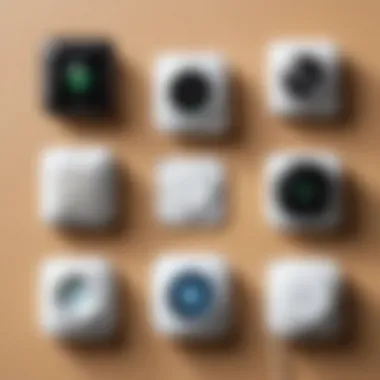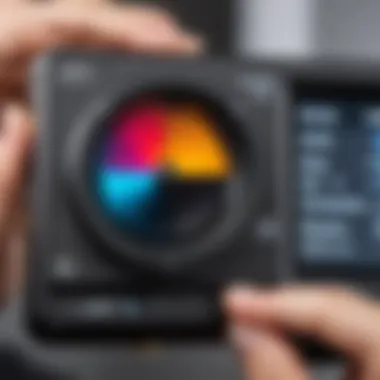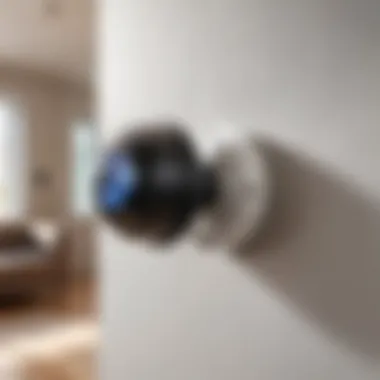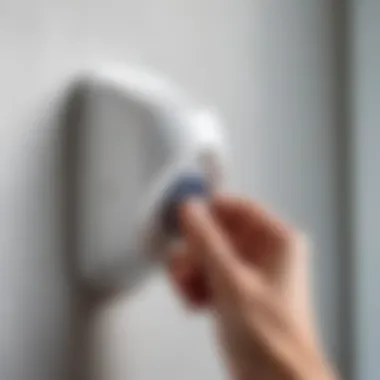Mastering Motion Sensors for Lighting Control


Intro
In the realm of home improvement, motion sensors have become a pivotal component of modern lighting systems. Understanding these sensors and their functionality is crucial for both DIY enthusiasts and professionals. This article will explore various aspects, including how to select the right motion sensor, adjust sensitivity settings, and install them properly.
Motion sensors can enhance energy efficiency by activating lights only when necessary. This not only reduces electricity bills but also adds a layer of convenience to daily life. As we delve into the technical specifications and installation tips, the goal is to provide a comprehensive resource that empowers users to make informed choices for their projects.
Проектирование и планирование
Как выбрать проект для DIY
Choosing a DIY project involving motion sensors entails understanding both your current needs and future potential. Consider what areas of your home would benefit most from automated lighting. Common locations include driveways, hallways, and outdoor areas like patios. Each of these settings presents unique challenges and requirements, impacting your choice of sensors.
When planning, think about the specific tasks the sensor will fulfill. Are you looking for security, convenience, or simply energy savings? These objectives will guide your selection.
Оценка времени и ресурсов
Estimating the time and resources is essential for a successful DIY installation. Generally, an installation can take anywhere from a few hours to a full day, depending on the complexity of the project. Consider these factors when planning your timeline:
- Type of sensor: Some sensors are easier to install than others.
- Wiring needs: Determine if additional electrical work is required.
- Tool requirements: Having the right tools handy can save time.
In addition, factor in the cost of materials and potential professional assistance. This foresight can prevent delays and additional expenses.
Выбор материалов
Типы материалов для различных проектов
The choice of materials directly affects both the performance and aesthetics of your installation. Here are common types of motion sensors:
- Passive Infrared (PIR) Sensors: Ideal for indoor use, these sensors detect changes in infrared radiation, usually from heat sources.
- Ultrasonic Sensors: These work by emitting sound waves and measuring their reflection, suitable for larger areas.
- Dual Technology Sensors: Combining PIR and ultrasonic methods, these sensors provide higher accuracy, minimizing false triggers.
Choosing the right type of sensor will depend on the specific environment and requirements.
Советы по покупке и экономии
When purchasing materials, consider these tips:
- Research prices online: Compare prices across different retailers to find the best deals.
- Read reviews: User reviews can provide insights into sensor performance.
- Look for sales or discounts: Timing your purchase can lead to significant savings.
By following these guidelines, you can optimize both functionality and cost-effectiveness in your lighting automation project.
Preface to Motion Sensors
Motion sensors play a significant role in automating lighting systems. This is particularly relevant for homeowners and professionals working on projects that involve energy efficiency and user convenience. Understanding motion sensors can lead to effective design choices that not only enhance security but also save energy.
With the rise in smart home technology, motion sensors have found more applications beyond just security. They are crucial in establishing a comfortable and responsive environment. From turning on lights when someone enters a room to adjusting based on ambient light conditions, these sensors elevate the user experience.
As we explore the intricacies of motion sensors, we will look into principles of operation, different types available in the market, and effective configurations. Users benefit by selecting the right sensor for their needs and properly adjusting it for maximum performance. This knowledge optimizes return on investment in home automation technologies.
What is a Motion Sensor?
A motion sensor is a device that detects physical movement in a specified area. Normally, these sensors generate electrical signals that activate lighting systems or security alarms based on their programming. There are various types of motion sensors that employ different technologies for movement detection. The most common types include passive infrared, microwave, and dual-technology sensors.


In simpler terms, motion sensors respond to the presence of people or pets within their range. This ability makes them ideal for not only security purposes but also for controlling light fixtures. Users enjoy the ease of walking into a room and having the lights turn on automatically without flipping any switches.
Common Applications in Home Automation
Motion sensors have diverse applications in home automation that cater to both practicality and safety. Here are some notable uses:
- Lighting Control: Automatically turning lights on or off based on movement helps in conserving energy.
- Security Systems: Motion sensors trigger alarms or notifications when unauthorized movement is detected in sensitive areas.
- Smart Home Integration: They can seamlessly integrate with larger smart home systems, coordinating functions with other devices like cameras and smart locks.
- Energy Saving: By activating lights only when needed, these sensors significantly reduce electricity consumption.
Motion sensors not only add convenience but also enhance safety while being eco-friendly.
As technologies evolve, the functionality of motion sensors continues to expand, paving the way for more innovative solutions in smart living spaces.
Types of Motion Sensors
Understanding the different types of motion sensors is essential for anyone interested in activating lights through motion detection. Each type has unique characteristics, advantages, and limitations that affect its operation and suitability for specific environments. By knowing the types of motion sensors available, users can choose the right one for their needs, thus ensuring efficiency and functionality in their lighting systems. This section will explore three main types: Passive Infrared (PIR) Sensors, Microwave Sensors, and Dual-Technology Sensors. Each type's specific mechanisms and applications will be discussed in detail.
Passive Infrared (PIR) Sensors
Passive Infrared (PIR) sensors are one of the most common types of motion detectors used in residential and commercial settings. These sensors work by detecting changes in infrared radiation, which is emitted by humans and animals. When a moving object enters the sensor's field of view, it triggers the detection mechanism, activating the lighting system.
Benefits of PIR sensors include:
- Cost-effectiveness: They are generally less expensive than other types of sensors.
- Low power consumption: PIR sensors require minimal energy to operate, making them eco-friendly.
- Ease of installation: The design is straightforward, allowing for quick installation.
Despite their advantages, there are factors to consider. They are not very effective if the moving heat source is too far away, and they can be affected by environmental conditions. For example, direct sunlight or drafts may cause them to malfunction, leading to unintended consequences.
Microwave Sensors
Microwave sensors, unlike PIR sensors, emit microwave signals to detect motion. These sensors send out microwave energy and measure the reflection that returns. When a moving object alters the wave patterns, the sensor triggers the activation.
Advantages of microwave sensors include:
- Greater detection range: They can cover a larger area and detect motion even through walls or obstacles.
- Versatility: These sensors work well in various environments, including indoors and outdoors.
- Sensitivity to small movements: They can detect minute movements that PIR sensors might miss.
However, these sensors may have drawbacks. They could lead to more false alarms if they are too sensitive, especially in areas with pets or frequent foot traffic. Additionally, they are generally more expensive than PIR sensors and may be more complex to install.
Dual-Technology Sensors
Dual-technology sensors combine both Passive Infrared and Microwave technologies. This integration allows them to capitalize on the strengths of both sensor types while minimizing their weaknesses. They require both technologies to detect movement before activating the lighting system.
Benefits of dual-technology sensors include:
- Reduced false alarms: The combination of technologies ensures that both types of motion must be detected before activation, reducing unnecessary triggers.
- Improved accuracy: This setup leads to a more reliable detection method, particularly in environments prone to interference.
- Flexibility in application: They can adapt better to various settings, whether commercial or residential.
On the downside, dual-technology sensors come at a higher price point and may complicate the installation process. They require thorough understanding for proper setup and calibration to function optimally.
Understanding these types of motion sensors provides valuable insight for anyone considering their installation for light activation. Each type has specific conditions under which it excels, ensuring users can make informed choices for their projects.
Understanding Sensor Sensitivity
Understanding the sensitivity of motion sensors is crucial for achieving optimal illumination and energy efficiency in lighting activation systems. Sensitivity settings determine how responsive a sensor is to movement. This is important because if sensitivity is set too low, the sensor may not activate when needed. Conversely, if it is too high, it may trigger alarms or lights unnecessarily. Adjusting these settings correctly ensures that lighting operates effectively, saving energy and enhancing safety in a home environment.
Defining Sensitivity in Motion Sensors


Sensitivity in motion sensors refers to the degree to which a sensor can detect motion in its designated area. It is measured in terms of response distance and the minimum movement needed for activation. For instance, passive infrared (PIR) sensors detect changes in infrared radiation caused by a warm body moving across their field of view. Meanwhile, microwave sensors send out radio waves and detect motion based on the change in frequency of the returned signal. Sensitivity settings often can be adjusted to align with the specific needs of the user and the location of the sensor.
Factors Affecting Sensitivity Settings
Several factors influence the sensitivity settings of motion sensors. These include:
- Environmental Conditions: Wind, rain, and temperature changes can impact performance.
- Sensor Type: Different types of sensors have varied sensitivity levels and detection range. For example, microwave sensors may detect smaller movements than PIR sensors.
- Installation Height: The height at which a sensor is mounted can also affect sensitivity. Higher placements may miss low-level movements.
- Furniture and Obstacles: Objects blocking the sensor’s line of sight can affect performance, limiting its ability to detect motion.
Understanding these factors allows users to adjust sensitivity appropriately, reducing the risk of false triggers and ensuring reliable activation when needed.
Adjusting Sensitivity for Optimal Performance
Adjusting sensitivity for optimal performance involves balancing the need for detection and the avoidance of false triggers. Most motion sensors come equipped with dials or switches to set threshold levels for movement detection. Here are some tips for effective adjustment:
- Test the Response: Walk within detection range at the planned mounting height and note the activation distance.
- Gradual Adjustments: Make small changes to the sensitivity settings and test extensively before finalizing.
- Monitor Environmental Impact: Be mindful of how environmental elements like wind or rain impact sensor performance and adjust accordingly.
- Regular Checks: Conduct regular tests, especially if changes are made in the layout of the surroundings, such as moving furniture.
By fine-tuning sensitivity settings, users can enhance performance, prevent unnecessary activations, and ensure a responsive lighting system that adapts to movement effectively.
Installation Considerations
When utilizing motion sensors for light activation, the installation process is crucial. It impacts not only how well the sensors function but also their overall efficacy in energy management and safety. Getting the installation right means ensuring the devices will respond promptly to movement, reducing unnecessary power consumption, and providing adequate illumination where it is needed most. A well-planned installation can also minimize the potential for false triggers, which may otherwise lead to frustrations and inefficiencies.
Choosing the Right Location
The location of the motion sensor is paramount for optimal performance. If the sensor is placed incorrectly, its ability to detect movement may be compromised. Here are critical factors to consider:
- Coverage Area: Ensure the sensor's field of view covers the intended area without obstruction. Fixtures or furniture can block the sensor, preventing it from detecting movement.
- Environmental Factors: Outdoor sensors should be resistant to weather conditions. Consider wind and rain which can affect performance.
- User Lifestyle: Analyze daily routines. Placing sensors in areas frequently traversed by inhabitants leads to better activation rates.
Selecting the right spot can vastly improve the effectiveness of the motion sensor, enhancing both convenience and security.
Mounting Height and Angle
The height and angle at which the sensor is mounted also contribute significantly to its effectiveness. The general guideline is that the sensor should be installed at a height of 6 to 8 feet. This height helps ensure the best coverage while minimizing obstructions.
- Adjustable Angles: Many modern sensors offer adjustable brackets. Utilize these to fine-tune the sensor's coverage area, pointing it directly towards the most common path of movement.
- Avoid Direct Sunlight: Sensors exposed to direct sunlight may have a reduced ability to detect motion properly, especially during bright days. Installing them in shaded areas can mitigate this concern.
- Test Placement: It is beneficial to test the positions thoroughly to determine if adjustments are needed for optimal detection.
Wiring and Power Supply
The connection methods for motion sensors can vary widely based on the technology used. Understanding the wiring and power supply options is essential for functionality.
- Power Source: Consider whether the sensor will be hardwired or if it will operate on battery power. Hardwired units can provide consistent power, while battery-operated ones offer flexibility in placement but require regular maintenance.
- Wire Management: Ensure that the wiring is neat and secured to avoid hazards. Plan for cable runs to be as unobtrusive as possible.
- Safety Precautions: Always follow safety guidelines when dealing with electrical installations. If unsure, it might be wise to consult a professional.
These installation considerations serve as fundamental principles that can lead to a successful motion sensor setup. By keeping these elements in mind, individuals can maximize the utility and reliability of their motion-activated lighting systems.
Testing and Calibration
Testing and calibration of motion sensors are crucial for their effective deployment in light activation systems. Properly tested and calibrated sensors ensure reliable functionality and efficient energy use. The primary aim is to achieve optimal performance tailored to specific environments and user needs. This process helps in avoiding common operational issues that can arise from incorrect settings.
Initial Testing Procedures
Initial testing involves a systematic evaluation of the motion sensor’s performance as soon as it is installed. The objective is to confirm that the sensor activates the lighting system correctly under the right conditions. Noteworthy steps in this procedure include:
- Visual Inspection: Begin by checking the physical installation of the sensor. Ensure it is correctly mounted and that there are no obstructions that might interfere with its detection capabilities.
- Power Supply Check: Verify that the power supply is stable and within the specifications as outlined in the manufacturer’s documentation. Testing should involve checking connections and the integrity of wires.
- Activate the Sensor: Walk through the detection area at various speeds and distances. Observe whether the lights respond each time. This will help identify any dead zones where the sensor does not detect motion or areas where it may be too sensitive.


Thorough testing during this phase allows for the identification of immediate issues that can be rectified before fine-tuning.
Fine-Tuning Sensor Response
Once initial testing is completed, fine-tuning can be conducted to enhance the sensor’s performance. Calibration focuses on adjusting settings for specific environments to minimize false triggers or non-activation.
Key considerations when fine-tuning include:
- Sensitivity Adjustments: Many motion sensors come equipped with adjustable sensitivity settings. Modify these settings according to the specific needs. If the area is prone to small movements, lower the sensitivity to prevent unnecessary activations.
- Time Delay Settings: Configure the time delay setting, which determines how long the lights remain on after motion is detected. Setting the delay too short can lead to lights turning off too quickly, while a longer delay might waste energy.
- Environmental Factors: Observe any changes in environmental conditions post-installation, such as increased foot traffic or moving objects. Adjust the settings as necessary to cope with changes.
Through careful fine-tuning, one can create a balance between responsive lighting and energy conservation.
"Proper testing and calibration of motion sensors leads to significant improvements in their reliability and efficiency."
Finally, routine monitoring post-installation can help to track the sensor's performance and facilitate adjustments as needed. This ensures that the motion sensors continue to function optimally over time.
Common Issues and Troubleshooting
Understanding common issues and troubleshooting is crucial to ensuring that motion sensors function effectively in lighting activation. The potential for operational defects or malfunction not only affects convenience but also energy efficiency and safety. Addressing these issues promptly will lead to enhanced performance and reliability of lighting systems, which is particularly important for those relying on these features in their homes. The following subsections delve into specific problems often encountered, providing insights and solutions that can help in maintaining optimal sensor function.
Sensor Not Activating
One of the most common problems with motion sensors is failure to activate when required. Various factors contribute to this issue. First, check the power supply to confirm that the motion sensor is properly connected and receiving voltage. Sometimes connections may become loose or corroded over time, leading to interrupted activity. Another critical aspect is the sensor settings. Ensure that both the sensitivity settings and timing settings are configured to suit the environment. For instance, using a high sensitivity in an area with obstructions may cause the sensor to become unresponsive.
Environmental factors also play a role. If the sensor is installed in an area that is too bright, it may not activate due to its light-sensitive nature. Therefore, careful consideration of the surrounding conditions during installation can make a significant difference. Lastly, ensure that the sensor is clean and free from debris that may obstruct its lens, as dust can impair detection capabilities.
False Triggers and Adjustments
False triggering is another frequent issue with motion sensors. This phenomenon occurs when the sensor activates without any actual movement detected. Common reasons for this unwanted behavior include heat sources like HVAC vents or sunny windows that can be misread as motion. This can lead to unnecessary activation of lights, wasting energy.
To mitigate such occurrences, adjust the sensor's sensitivity level. A lower sensitivity may be required in environments where pets or thermal movements are common. Additionally, consider recalibrating the sensor positioning. Aim to mount the sensor at an angle or height that minimizes exposure to these false triggers. Some models even allow for directional sensitivity adjustments to further tailor their responsiveness.
Energy Efficiency and Safety
Energy efficiency and safety are critical factors to consider when integrating motion sensors into lighting systems. The incorporation of motion sensors can lead to significant reductions in energy consumption. By only activating lights when necessary, these sensors minimize waste, contributing to lower electricity bills and a more sustainable environment. In a world where energy conservation is becoming increasingly important, understanding the benefits of motion sensors aligns with broader efforts to promote eco-friendly practices.
When assessing the benefits of energy efficiency in motion sensors, it is essential to recognize that they optimize the usage of electrical power. For instance, when no motion is detected within a specified timeframe, the sensor can turn off the lights automatically. Studies show that buildings equipped with motion sensors can reduce energy usage by up to 30%. This substantial saving not only makes economic sense but also reduces the carbon footprint of the household or facility, reinforcing commitments to environmental stewardship.
However, while pursuing energy efficiency, safety considerations also play a paramount role in installation and operation. It is vital to ensure that motion sensors do not compromise security or convenience. Users should be aware of potential hazards, such as placing sensors in locations prone to interference or false triggers. For example, excessive motion—like activity from pets—can cause unnecessary light activation, potentially leading to energy waste rather than conservation. Thus, proper calibration and strategic placement of sensors becomes crucial in order to balance safety with efficiency.
"Integrating motion sensors into residential and commercial spaces is not merely about energy savings. It is a holistic approach incorporating safety and accessibility."
Closure
The conclusion highlights the critical aspects discussed in this article. Motion sensors play a pivotal role in enhancing energy efficiency and safety in home automation. Understanding the functionality and implementation of these sensors allows homeowners and professionals to make better choices. It is essential to consider various factors such as sensitivity settings, installation practices, and troubleshooting methods to ensure optimal sensor performance.
This article emphasized the importance of careful installation and configuration. Proper placement and adjustment of sensitivity can greatly impact how effectively a light activation system operates. Additionally, addressing common issues can help prevent frustration and ensure functionality. As we conclude, it is worthwhile to reflect on how the advancements in technology will shape the future of motion sensors.
Recap of Key Points
- Types of Sensors: The main types of motion sensors are Passive Infrared (PIR), microwave, and dual-technology sensors. Each type has its own advantages depending on the application.
- Sensitivity Settings: Sensitivity is crucial for the effectiveness of motion sensors. Factors influencing settings include the environment and intended usage.
- Installation Practices: Choosing the right location and ensuring correct mounting height are vital for optimal operation. Wiring and power supply considerations are equally important.
- Troubleshooting: Understanding common issues like non-activation and false triggers is necessary for maintaining efficient sensor function.
Future Trends in Motion Sensor Technology
As technology evolves, motion sensors are expected to become smarter and more integrated into home automation systems. Trends include:
- Increased Connectivity: Sensors will likely integrate more with IoT devices, providing seamless control and monitoring.
- Enhanced AI Functions: Advanced algorithms will enable sensors to learn patterns and improve accuracy in detecting motion.
- Energy Harvesting Tech: Future designs may incorporate energy harvesting capabilities, enabling sensors to operate without an external power source.
In summary, the motion sensor technology landscape is changing rapidly. Those involved in design and installation must stay informed about innovations to maximize the benefits of these devices.







